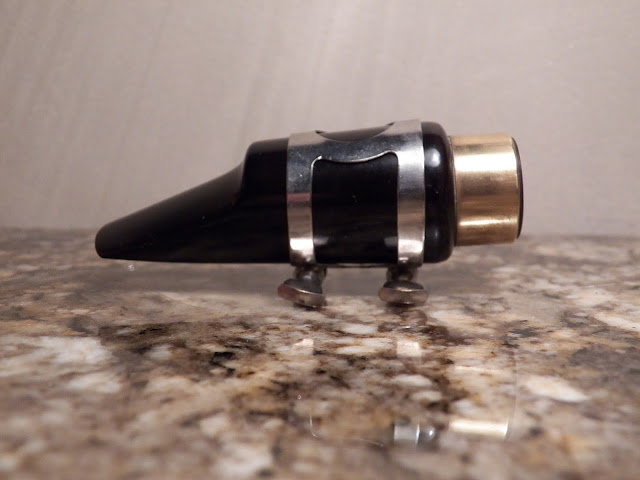One of the oddest mouthpieces that I have come across is the Gale "Triple-Rail" mouthpiece. Lots of vintage mouthpieces have tried things to differentiate themselves from conventional mouthpieces. Odd shaped chambers, metal tables, anything to make the mouthpiece stand out. Of course, the manufacturer also has to make a claim as to why the design modification is superior, or what problem it solves, or how it improves the sound or tuning or something. As we have seen with musical accessories, the claim doesn't need to be true or even make sense.
Most of the inventive changes to saxophone mouthpieces over the years claim that the modification improves the sound when in fact it is often only the visual aspect of the mouthpiece that has changed. The white Brilhart Tonolin mouthpiece is claimed to sound different than the original black Brilhart Ebolin mouthpiece. Nobody can agree on what the acoustical difference is, and nobody can tell in a blind testing, so there is not likely any difference caused by the color. Also, having been produced by the same mold makes a rational person doubt any acoustical difference. But as musicians, we don't have to be rational. I am sure that some would argue that they know what a red Brilhart Rubylin mouthpiece would sound like. Maybe bloody good? A rosy tone?
Mouthpieces have occasionally taken on a novelty design. I believe that the Gale Triple-Rail is one of those. Try as I might, I could find no information on just what problem the "middle rail" was intended to solve. Or what improvement resulted from having a rail down the middle of the chamber. A radical design change should be a refinement that outweighs any negatives caused by the change. That doesn't seem to have happened with the Triple-Rail. There was no "up side" and lots of "down side."
First, some background. In about 1948, Mr. Carl Satzinger formed a corporation with several of the principals from Rico Products, famous for their woodwind reeds. Mr. Satzinger was the son-in-law of a Rico employee who was involved with Rico's mouthpiece fabrication. Mr. Satzinger had some college training as an engineer and started a business with Roy Maier, Frank De Michelle, and Nathan Snyder, all principals at Rico. The venture was incorporated and Mr. Satzinger opened his own shop with a business address. The company was named "Gale Products" after Mr. Satzinger's daughter Gale.
Gale Products was short lived, lasting less than a year. Some of the first mouthpieces stamped Gale appear to have been made from blanks using Rico's existing line of mouthpieces (the M.C. Gregory model). But others were clearly from different blanks, maybe even designed by Mr. Satzinger. The Gale Products molds were sold to a local jeweler when Gale was dissolved after less than a year. The jeweler later sold them to Charles Bay, a well-known clarinet instructor and mouthpiece facer. Below is a picture of a selection of blanks made from the Gale Products molds.
The Gale Products Triple-Rail mouthpiece that I'm writing about is a curious modification of one of the Gale molds. If you look at the above picture, it is shown on the lower right, the third one in (with an aluminum shank band). There is a rib or "rail" down the center of the chamber. There is another Triple-Rail on the upper right, second one in. That one apparently had the rib mostly broken off. There is no way of knowing what percentage of the Triple-Rail castings ended up defective, but it would certainly make production more costly than a regular chamber.
The following are pictures of my unfinished Gale Triple-Rail blank.
There are a couple of things that stand out about this rough blank. First, the mold line on the beak doesn't seem to run down the center of the beak. When looking from the tip (above picture), you can see how asymmetrical the tip is. That is not going to be very easy to work with. It requires a lot of shaping, something that the molding process was intended to reduce. Even the third rail down the middle isn't symmetrical. This appears on many, but not all Third-Rail mouthpieces. There is simply no way to fix that when finishing the blank.
Another common flaw on these is that the middle rail tend to chip right where it meets the top of the window. The picture below is a close-up of the flaw on my blank. Right at the top of the rail a tiny piece is missing. Not that it matters, as we will see when this mouthpiece is finished.
The actual middle rib is often warped and can have minor casting flaws on it. In the picture below you can see a little blister on the "curtain" that forms the middle rail. It could be removed but I didn't bother. You can also see that the inside of the mouthpiece suffers from the brown oxidation found on most 75 year-old ebonite mouthpieces.
I wrote the original lay on the blank. It was fairly even side-to-side, but with a close tip opening at .050 inch for an alto mouthpiece. The lay is 20 mm (a Brand number of 40) which is long for that tip. This is probably a preliminary lay from which a larger and more precise lay can be fabricated. On the following picture, you can again see at the start of the third rail the little indentation from a tiny bit of material missing as was mentioned above.
I was curious if the three rails were all even. Normally, when using a ruler to measure the lay, you have only two rails. What if the middle rail was high? Or low? Turns out that it basically has to be low. But in first examining it I got a little moisture on the glass and pressed the rails against it to see how they lined up. The middle rail seemed a little high. Any side-to-side pressure difference when putting on a facing would cause the center rib to be higher. Uneven rails can be a problem, but the center rail would really accentuate even a tiny difference that would normally be unnoticeable.

Next was flattening the table and beginning the cut for the lay. I should note that the tip opening I wrote on the table above was kind of an interpolation. Because there is rail right down the center of the tip opening, the usual methods of measuring were not possible. With the Triple-Rail, the tip opening can be a bit of a guess.
I thought that the drop into the chamber at the tip looked like it might sound a little dull. Time to think about maybe working the insides towards the tip and get a little baffle. Unlike a normal mouthpiece, this meant working on both sides of a middle rail.
Finally I had a responsive mouthpiece. Did it have any special color to the sound? No. It was just a nice vintage piece. This mouthpiece was not marked in any way and never had the three white dots put on it, but adding dots is really a simple (although time consuming) project that, like the third rail, adds nothing to the piece (for most players).
The interior had a lot of oxidation that I haven't yet cleaned up. Which raises another practical problem with the Triple-Rail (problem #22?). How do you swab out the mouthpiece to keep it from looking like this? This blank had never even been played! Is there a special Rico Triple-Rail mouthpiece swab? My guess is that Mr. Satzinger's experienced business partners would have nixed the idea of having Satzinger design a Triple-Rail mouthpiece swab.


















Thanks for sharing your experiments!
ReplyDelete